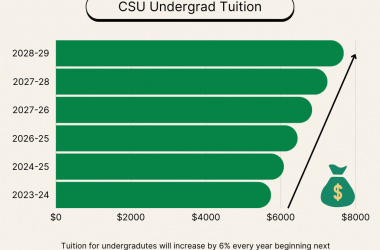In his first year as the recycling coordinator, Lee Johnson had tried to make the university recycling program more efficient.
Associated Students Inc. was no longer subsidizing its recycling center as it had in previous years, when it subsidized the center $28,000 in 2006-07. There were even plans to upgrade the center’s facilities, which consist of a trailer that leaks, an outhouse and no running water.
Then the crises hit.
In fall 2008, the country’s financial sector started teetering, and so did the commodities market for the scrap material recycling centers sell.
For example, a ton of cardboard that once sold for $105 to $110 dropped to $5, Johnson said. The aluminum market wasn’t immune to this either; it dropped from $1 a pound to 38 cents a pound in late 2008.
“Recycling took the fastest and the steepest loss that I have seen in 35 years in the recycling [business],” Johnson said.
Even Johnson’s colleagues, some of whom were in the business before him, told him they didn’t remember ever seeing this fast of a drop in the commodities market.
The recycling business wasn’t the only one suffering from the country’s economic woes — the state of California wasn’t doing so well either.
With the state struggling with budget deficits, Johnson said the state borrowed about $90 million from the Beverage Container Recycling Fund, which California uses to offset the cost of paperwork and recycling efforts at recycling centers.
Sacramento’s recycling fund
The state’s recycling fund comes from manufacturers, which must pay 5 to 10 cents for California Redemption Value (CRV) recyclable containers.
Manufacturers get their money back from vendors like supermarkets, which then charge consumers for the CRV fee. Consumers may get their money back from state certified redemption centers— recycling centers —which eventually are reimbursed by a state-certified processor.
Processors receive from the state the CRV fee that manufacturers paid to the government in the first place. In other words, the CRV fee is passed along all the parties involved, with everybody being reimbursed for the 5 to 10 cent fee per recyclable container.
However, not all consumers recycle every container. As a result, there is a surplus in Sacramento’s recycling fund that is then used to help pay for the paperwork and other expenses that state certified redemption centers and processors must endure.
One of the expenses includes the cost of recycling low-value materials like glass, Johnson said. Scrap glass doesn’t net enough profit from the commodities market to cover cost of recycling it, putting recycling centers at a loss.
The difference between the value of the scrap glass and the cost to recycle it is reimbursed by the state via the CRV fund.
However, the state has delved into its recycling fund over the past 10 years and especially this past year, Johnson said. Consequently, there isn’t enough money in the recycling fund to pay centers, like ASI’s recycling center, for all of its additional expenses.
According to Johnson, there is still enough money in reserves to pay for expenses at ASI’s recycling center this fiscal year.
“Assuming we deplete our reserves this year, then for next year [ASI will] have to decide whether or not to subsidize the [recycling] program unless, of course, a bill passes,” Johnson said.
Efforts to stabilize state’s recycling fund
Two things can stabilize the Beverage Container Recycling Fund: lawsuits or state legislation.
The California Chamber of Commerce is among those suing the state of California to return the money back to the recycling fund.
“It is illegal to borrow that money,” Johnson said.
ASI president Chris Chavez previously told the Daily 49er that the state was “pretty much obliged to give that funding to make sure these centers are operational.”
Also, legislators tried to pass Senate Bill 402, which would’ve strengthened the recycling fund by raising the CRV fee on some containers, according to an article by the WIH Resource Group. Gov. Arnold Schwarzenegger vetoed that bill, saying the bill would’ve hurt consumers.
Future of ASI Recycling Center
Johnson said the recycling center might have to stop some of its services if the state doesn’t begin paying the center the amount the state used to from the state’s recycling fund.
Among the services that the center provides are hosting for environmental education for children, picking up recyclables from areas in and around Cal State Long Beach, and providing tours for students from middle school and high school.
One other solution would be that ASI could re-subsidize the recycling center. Johnson made it clear that the decision would be up to ASI and not the recycling center.



